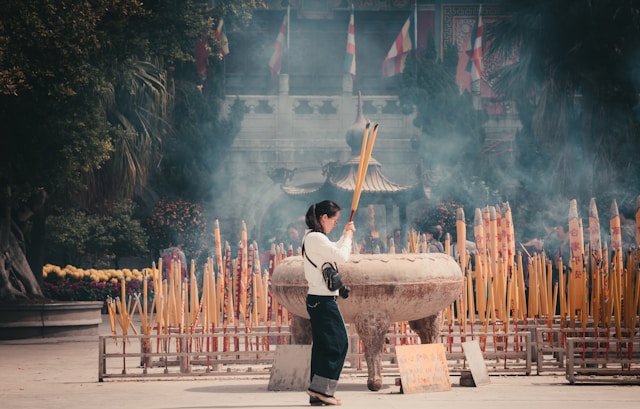
A Peaceful and Respectful Experience about Temple Etiquette in Japan
When you visit a temple in Japan, it’s not just a place of worship—it’s a space for reflection, mindfulness, and tradition. Whether you’re exploring the serene beauty of Kyoto’s Zen temples or visiting a Shinto shrine, understanding proper etiquette will enhance your experience and show respect for the local customs.
This guide will help you navigate the dos and don’ts of temple visits, ensuring you make the most of your visit while being respectful to the sacred space.
1. Dress Modestly and Neatly
Japanese temples are places of spiritual reflection, so it’s important to dress appropriately. Here’s what to keep in mind:
- Cover your shoulders and knees: Avoid wearing shorts, sleeveless tops, or anything too casual.
- Shoes off at certain places: Be prepared to remove your shoes when entering temple halls, especially in places like the main prayer halls and inner sanctums. Wear clean socks or slippers!
- Simple attire: Choose calm, neutral colors to blend in with the serene environment.
2. Be Quiet and Respectful
When you enter the temple grounds, you’re entering a place of peace and spirituality. The atmosphere encourages silence and reflection, so keep noise to a minimum.
- Speak in whispers: Talk quietly or not at all.
- Avoid loud gestures: Avoid loud laughter, shouting, or using your phone for photos or conversation. Some temples may even ask that you silence your phone completely.
- Mind your movements: Move slowly and gently through temple grounds and halls.
3. Follow the Rituals
When you visit a temple, you may encounter various rituals and offerings. It’s important to participate respectfully, even if you’re unsure of the full meaning of each action.
At Shinto Shrines:
- Purification: Before entering the main shrine, you’ll often find a water basin (temizuya) where you can purify yourself. Use the ladles to wash your hands and mouth.
- Offering: Place a small offering in the donation box, bow twice, clap your hands twice, bow again, and then silently make your prayer or wish.
At Buddhist Temples:
- Incense Offering: You may encounter incense burners where you can light a stick of incense as an offering to the Buddha. Wave the smoke toward yourself for blessings.
- Chanting and Meditation: At some temples, there are opportunities to join in sutra chanting or zazen meditation. If you choose to join, follow the monks’ lead.
4. Keep Your Distance and Avoid Touching Sacred Objects
Temples are places of worship, and many areas are considered sacred. As a sign of respect, avoid:
- Touching statues or offerings: Don’t touch or climb on religious statues, bells, or other sacred items.
- Entering restricted areas: Stay outside the ropes or barriers that indicate restricted zones.
- Taking intrusive photos: Always ask if photography is allowed. Some temples may have specific rules about taking pictures inside sacred areas.
5. Be Mindful of Others
While temples are public spaces, they are also places where people come for prayer and reflection. Keep this in mind during your visit:
- Respect personal space: Give people their space while they’re praying or meditating. If you must walk by someone in a prayer area, do so quietly and respectfully.
- Avoid interrupting ceremonies: If you arrive during a religious ceremony, such as a morning prayer or ritual, be silent and stay at the back to avoid disrupting the service.
- Don’t rush your visit: Take time to enjoy the surroundings and reflect. The temples are designed to offer a peaceful environment.
6. The Etiquette of Offering Prayers
When you make a prayer at a Buddhist or Shinto temple, there are specific rituals to follow:
- Buddhist Temples: After offering incense, bow slightly, and silently offer your prayer. You can ask for peace, good health, or blessings.
- Shinto Shrines: After washing your hands and mouth, toss a coin into the offering box, bow twice, clap twice, bow again, and pray silently.
7. Show Gratitude Before Leaving
Before you leave, take a moment to reflect on your visit and express your gratitude:
- Bow before exiting: As a sign of respect, give a small bow before leaving the main temple hall.
- Respect the surrounding nature: Be mindful of the temple garden, paths, and natural features. Many temples have beautifully kept grounds that reflect Zen philosophies of nature.
📌 Related Article: Silent Traditions: Attend Morning Ceremony at a Japanese Temple
Final Thoughts about Temple Etiquette in Japan
Visiting a Japanese temple is an opportunity for spiritual insight, cultural understanding, and personal reflection. By following the etiquette outlined in this guide, you will not only show respect for the traditions but also create a more meaningful and enriching experience for yourself.
If you’re planning to visit a temple in Japan, make sure to approach it with an open heart and mind, ready to learn and appreciate the quiet beauty of Japan’s sacred spaces.




